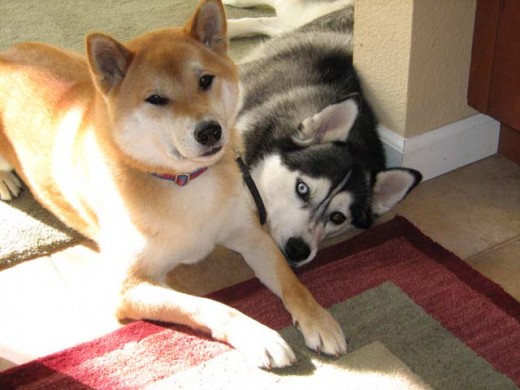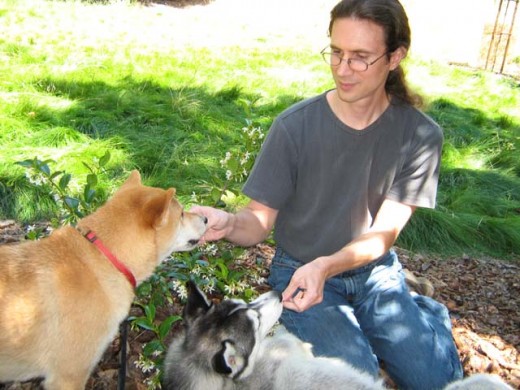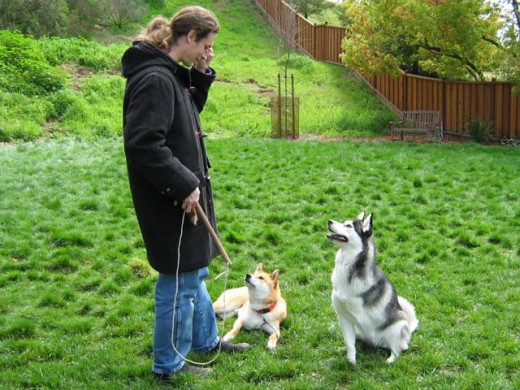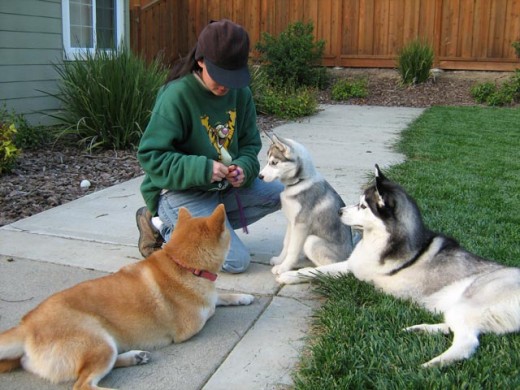Spanking, beating, and hitting a dog, is sometimes used as a form of dog discipline or dog punishment.
After all, biting a dog’s ear worked for Cuba Gooding Jr. in the movie Snow Dogs. Therefore, will such pain based techniques work for us too? To answer this question, we must consider how dogs learn.
Dogs learn through conditioning.
- They repeat behaviors that get them good results, and
- They stop behaviors that get them bad results.
Based on this, there are two schools of thought for stopping problem dog behaviors – reward obedience training and aversive obedience training.

Is It Bad to Beat or Hit a Dog?
Spanking, beating, and hitting a dog are all aversive techniques. Pain is delivered to sensitive areas of the dog, such as his ear or muzzle, when he performs a bad behavior.
The argument for this type of dog discipline, is that the pain will discourage a dog from repeating undesirable actions. Every time our dog does something bad, he gets an unpleasant result (pain), which will hopefully dampen his resolve to perform the same behavior.
However, the problem with aversive training, is that it is risky, too personal, and there is no good way to redirect the punishment.
Our dog knows that the pain originates from us, and is not a natural result of his actions.
As a consequence, our dog may end up learning the wrong lessons, including:
- Hitting, slapping, and biting is a fun game that my owner plays with me. Let me try playing it with him, and with others. A dog may arrive at this conclusion, when the pain is not delivered with enough force. Too much force, however, may result in fear aggression.
- A person’s hand or face coming toward me, is a bad thing. I should run away from people, or bite the hand or face that is a threat to me.
- My owner, or a person coming toward me, means pain. I should stay away from people, or keep them away by growling and biting.
If we do not deliver the pain with good timing, with the proper force, and in exactly the right circumstance, our dog may get confused as to why he is getting punished. He may become fearful and stressed, because he is unsure how he can stop the pain from recurring.
As a result, spanking, beating, and hitting a dog may lead to even more behavioral issues, including fear aggression as well as submissive urination.
For these reasons, using physical techniques to punish a dog, is not very good dog kung fu.

If Not Beating or Hitting a Dog, Then What?!
If beating or hitting a dog does not work, then how can we teach our dogs right from wrong?
How can we get our dogs to behave and not engage in destructive behaviors?
The answer lies in the other school of dog discipline, namely reward based techniques. Some positive based authors that I like include Patricia McConnell, Karen Pryor,
and Suzanne Clothier.
Contrary to what some may say, reward based methods does not just involve “giving food to our dog”. Rather, it allows us to gain pack leadership through the proper control of resources.


We may not realize this, but we already control all of our dog’s resources. For example, we decide when he gets to walk, when he gets to eat, what and how much he gets to eat, when he gets to play, what toys he gets to play with, when he has to go to sleep, what he can chew on, and much more. All we need to do, is teach our dog this fact –
He is NOT in control, WE are.
For example, if my dog jumps on me and bites my hand during feeding time, I tell him that this behavior is unacceptable, by using a no-mark. Then I ignore him, and he does not get his food, until he has calmed down. In this way, he learns that –
- Waiting calmly for his food in a down position = Get food quickly,
- Jumping and biting = Food preparation stops.
If he continues with his bad behavior, I say Time-out, and I remove him to a time-out area. This teaches him that if he cannot behave around people, then he does not get to be with people.
We respond to all other bad behaviors in a similar way – by restricting our dog’s access to his most desired resources, and only giving him rewards when he has earned them through good behavior.
Different dog behavioral issues will involve different tactics, but the overall strategy is one of resource control and proper management.

But Dogs Hit, Bite, and Physically Correct Each Other …
A common argument used to justify physical corrections, is that our dogs do that to each other, therefore, it must be natural and right.
It is true that dogs will sometimes hit and bite each other as a warning, or to correct behavior. Dogs also hit and bite during play. They are able to do this, because they have very good control of the placement and force of their bites.
However, dogs are not humans and *we* are not dogs. We do not have the same physical strengths or control as our dog. We do not have sharp teeth or claws, we cannot run very fast, and our jaws are not very strong.
This is why it is a very bad idea to physically challenge stray or loose dogs. Logic dictates that we do not wrestle, hit, or physically engage with unknown dogs, that may be aggressive. Similarly, we should not slap, beat, or hit our own dog either. Rather than do a bad job at pretending to be a dog, we should play to our human strengths.
As a human,
- We can open and close doors.
- We can drive to the store and buy food, toys, and other good stuff.
- We can open sealed bags, cans, bottles, and more.
- We can reason, build, and develop long-term plans.
In essence, our human abilities give us control of *all* the things that our dog needs or desires. This makes us into natural leaders, because by controlling the pack’s resources, we control the pack.

Finally, when a dog physically corrects another dog, the other dog may decide to fight back.
A puppy may allow an adult dog to correct him initially, but when he grows up, he may learn to respond in-kind with aggression. For this reason and more, I do not allow my dogs to physically correct or bully each other. As pack leader, I set the rules, and I enforce them through the control of resources. If there are any conflicts, my dogs will alert me. I will then do my best to resolve the conflict in a fair and consistent way, which does not involve any hitting, biting, or puncture wounds.
Just because a dog may sometimes hit and bite other dogs, does not mean that hitting and biting is good, effective, or even particularly humane. The assumption or assertion that physical punishment is better because our dogs do it, is a logical fallacy. In fact, there are many things that dogs do to each other and to other animals, that we need to manage, redirect, and retrain. This includes –
- A dog’s drive to hunt neighborhood cats,
- A dog’s instinct to guard resources (with aggression if necessary),
- A dog’s inclination to bully a weaker dog,
- A dog’s impulse to fight-back, and more.

Does Beating or Hitting a Dog Work?
Pain based techniques may stop problem behaviors in the short term, but it is not the most effective type of dog discipline.
There are many difficulties and risks that may cause our dog’s behavior to degrade, rather than improve. Using it to stop one problem behavior, may inadvertently cause five other bad dog behaviors to crop up. In addition, the effect of beating or hitting a dog may degrade over time, as our dog gets habituated to the pain.
In contrast, reward based methods are safer because there is little danger of our dog becoming fearful, aggressive, or stressed. We are not delivering any pain to him, but simply withholding the rewards that he has failed to earn.
- Reward based discipline encourages our dog to figure out how he can get in our good books, because that is the quickest way to get what he wants most.
- Aversive dog discipline, on the other hand, encourages a dog to avoid us because there may be pain involved.
Ultimately, resource based training allows us to forge a stronger bond with our dog, and makes him into a responsible canine, who works for what he wants.
The greatness of a nation and its moral progress can be judged by the way its animals are treated.
~~ [Mahatma Gandhi]


I witnessed someone kick a dog into his cage over a piece of food. I am disgusted with the person.
My dog all of a sudden attacked cat sitting in my lap. She severly injured the cat. I beat my dogs ass. One of the cats sneezed n the dog attacked her. I beat my dogs ass good. Im not sorry either.
My dogs training never involed smacking or hitting. Scolding, bad girl extent. My dog, obtained as a puppy,. She is 5 now. My cats 15 n 14. Like I said out of the hlue. As much as I believe n practice understanding both sides, theres no excuse for my dogs behavior. Neither cat came near the dog, touched the dog so the dogs not in pain. My dog went for the kill over a cat napping n another one sleeping. Im thinking mental problem.
I live in the hood n need my big dog. Unfortunately aIll be putting her to sleep soon.
I am an extremely fair parent, everyone gets a treat at treat time. If dog treats ran out no one gets a treat. Senior cat treats run out no one gets a treat. Bedtime everyone has the same spot for years. There is nothing new, nothing changed,in the house hold. Same ol us. Shockingly, dog going for kill over a sneeze.
How can I possible love my dog?
Currently, the fog is locked out of all the roomd except living room. She lost privledge of sleeping with ne n the cats.
Wrote this in the dark, patdon errors
Sounds like you need to take her to dog training, and learn also that some dogs are protective of their food. If she is demonstrating aggressive behavior, you might be too close to the food or too interested in the food. You need to leave her alone when she eats. Give her 15 mins with it when you go do your thing. If she doesn’t eat it, remove the food until the next meal. She will then learn that food is not available all the time and will grow hungry and cherish it and becomes grateful you brought it. You need to demonstrate you are the owner and in control by deciding when to eat and NOT, when to play and not. You sound like you are letting the dog make decisions, so she thinks you are inferior to you and can do anything to you. Do not let her sleep in your bed and you need to learn confidence and leadership. The fact that you cannot control her and feel a bit scared until you found a stick says that you are afraid of many things and not a confident and capable owner. If I can tell, a dog can sense it way more. Your dog thinks you are theirs and not the other way. You are probably the type that feels guilty if you don’t please your dog. You need to change that attitude. When she lunges at you, hitting her is the right response but NOT enough, You need to immediate grab her collar firmly and drag her dog on the floor and don’t let go, Then lower your voice and say no! very loudly as to intimidate her to immediately put her below you showing her you are the boss and even her biting does nothing to you to dominate her. Then spank her butt very hard once with your hands, and say “bad! No!” Immediately after this take her to a small enclosed, ark space for time out – without food, water or access to anything, say time out and close the door. Leave the dog for two hours, come back in with no expression on your face to check their attitude if they look guilty and humble themselves, you talk to them about what they did and tell them it was wrong with a firm, serious but not angry face and look at whether they are submissive and listening to you and wagging their tails to show they want to please you. If they are not, don’t talk to them and close the door for two more hours, until their attitude is completely one of humility and listening to you. Then you put the leash on them and lead them back to their crate and make them go in until meal time, and this time, you tell them what you want them to do, such as saying “eat!” If they don’t within 5 minutes, leash them back into the crate and remove the food until the next meal. Do not soften your stance until they submit to you. As a leader, next please or pay them affection until they have done something you commanded and did it well. Remember, dogs need owners and leadership, not soft maids
Were they kicking or just using their feet to prop them? Using your feet is often seen as not polite, but that is human opinion. Dogs don’t necessarily perceive it that way, and feet are closer to the dog and is not actually perceived by the dogs as aggression. Hands coming down is probably scary
I have a shiba and she’s very unpredictable. She can look cute and wagging her tail seeing me come home and wanting to play. I go out and play with her for some time. Then she ignores me and goes eat her dog food (literally watch her eat so she eats). Then moments later, unpredictably, she starts turning around and starts growling at me and then lunged at me and bit me for no reason. Luckily I found a metal stick nearby and smacked her with it to let go and she went full aggression on the stick. Now I have a bloody wound. Sometimes force is needed for these typa dogs and their unacceptable behavior.